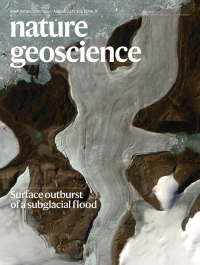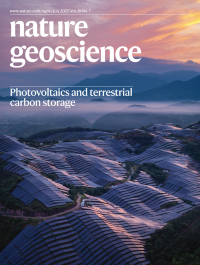Volume 18
-
No. 9 September 2025
Microscopic view of asteroid BennuImpacts at all scales have altered the surface of the asteroid Bennu. The image, taken by a scanning electron microscope, shows a micrometeoroid impact crater on a particle from Bennu returned by NASA’s OSIRIS-REx mission.
See Keller et al.
-
No. 8 August 2025
Surface outburst of a subglacial floodA subglacial flood in northern Greenland had sufficient power to fracture the ice sheet and outburst from the surface. The image, taken by a satellite shortly after this event, shows the newly formed fracture zone, water-scoured ice, and the 80-metre-deep basin above the drained subglacial lake.
See Bowling et al.
-
No. 7 July 2025
Photovoltaics and terrestrial carbon storageThe global installation of photovoltaic plants to harness solar energy between 2000 and 2018 led to an increase of 2.1 Tg C in terrestrial ecosystem carbon pools. The image shows photovoltaic panels installed across a mountainous rural landscape in China.
See Wang et al.
-
No. 6 June 2025
Hidden sulfur from submarine eruptionsLittle sulfur from the 2022 Hunga submarine eruption reached the atmosphere due to seawater–magma interactions, indicating that the climate impact of this type of eruption may be underestimated, according to analysis of volcanic ash. The aerial photo shows a plume rising from an earlier undersea volcanic eruption in March 2009.
See Wu et al.
-
No. 5 May 2025
Volatile cycling in early subduction zonesThe image shows 3.8-billion-year-old metamorphosed igneous rocks of the Innuksuac Complex on Hudson Bay's eastern shore that hold early geochemical clues to plate-tectonic-like activity. These rocks preserve sulfur and neodymium isotope signatures typical of sediment subduction at a continental margin, offering a rare glimpse into the biogeodynamic processes that shaped early Earth.
See Caro et al.
-
No. 4 April 2025
Mantle response to Aral Sea desiccationThe drying out of the Aral Sea induced flow of the relatively weak asthenosphere beneath, demonstrating that human activity can influence mantle dynamics, according to numerical simulations of ground uplift measured by radar interferometry. The aerial image shows the salty grounds of the Aral Sea in Kazakhstan.
See Wang et al.
-
No. 3 March 2025
Detecting winter meltwaterIn situ temperature and salinity measurements from a Greenland fjord by an uncrewed aerial vehicle suggest that subglacial meltwater is discharged during winter, impacting the fjord heat budget and biological production. The image, taken by a camera on the uncrewed aerial vehicle, shows densely packed fjord ice in front of the glacier Eqalorutsit Kangilliit Sermiat, South Greenland.
See Hansen et al.
-
No. 2 February 2025
Signs of magmatic unrestThe recent increase in isotopically light sulfur emissions from Campi Flegrei in Italy could be an indicator of caldera reawakening. The image shows vigorous volcanic gas discharge at the Bocca Grande fumarole of the Solfatara crater, Campi Flegrei.
See Aiuppa et al.
-
No. 1 January 2025
High mountain hazard cascadePerched at 3,600 m elevation in the Himalayan mountains of Nepal, massive glacial sediment deposits were incised by nearly 100 m in a geological instant during monsoonal flooding in 2021. The sediment unleashed by this event set in motion an erosional chain reaction with devastating consequences downstream, exemplifying the cascading hazard posed by sediment-laden floods in high mountains.
See Chen et al.









